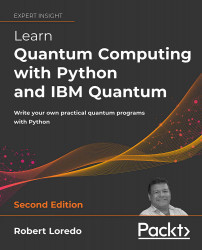This is the code repository for Learn Quantum Computing with Python and IBM Quantum, Second Edition, published by Packt.
Robert Loredo

The IBM Quantum Platform was built to enable developers to learn the basics of quantum computing by providing access to high performant quantum computers and provide documentation and courses to help get up to speed with the latest features in quantum computing.
Updated with new examples and changes to the platform, this edition begins with an introduction to the IBM Quantum Platform and the Quantum Information Science Kit (Qiskit) SDK. You will become well versed in the IBM Quantum Composer interface as well as running your quantum circuits on a real quantum computer. Along the way, you’ll learn some of the fundamental principles regarding quantum mechanics, qubits, quantum gates, quantum circuits, and the error mitigation techniques that are used to perform operations on qubits.
As you build on your knowledge, you’ll understand the functionality of IBM Qiskit and the developer-focused resources so you can create your own quantum algorithms. You’ll learn how to monitor and optimize your quantum circuits. Lastly, you’ll look at the fundamental quantum algorithms and understand how they can be applied effectively.
By the end of this quantum computing book, you'll know how to build quantum algorithms and will have gained a practical understanding of quantum computation that you can apply to your research or business.
- Get familiar with the features within the IBM Quantum Platform
- Create and visualize quantum gates and circuits
- Operate quantum gates on qubits using the IBM Quantum Composer
- Install and run your quantum circuits on an IBM Quantum computer
- Discover Qiskit and its many features such as the Qiskit Runtime
- Get to grips with fundamental quantum algorithms and error mitigation techniques to help you get started
- Understand the new era of quantum utility and how this moves us closer towards quantum advantage
- You will need to have internet access to access the IBM Quantum systems available to you. Since the platform is hosted on the cloud, you will not need anything more than a browser and to register a free account.
- You will also need an up-to-date browser (Firefox, Chrome, Safari)
- OS requirements (only if installing the software locally): Windows, Mac, and Linux.
Robert Loredo Robert Loredo is the IBM Quantum Ambassador Worldwide lead with over 20 years' experience in software architecture and engineering. He is a Qiskit Advocate and Master Inventor, listed as one of the world's most prolific inventors with over 200 patents. He has presented various workshops, lectures, and articles covering quantum computing, artificial intelligence, and bioinformatics worldwide. As an adjunct professor, he has taught cloud computing and software engineering at the Florida International University School of Computer Science. He holds both a bachelor's and a master's degree in Computer and Electrical Engineering from the University of Miami and is currently pursuing his PhD in Computer Science, specializing in Quantum Machine Learning and NeuroInformatics, at Florida International University. As a philanthropist, one of his favorite charities is Doctors without Borders.


